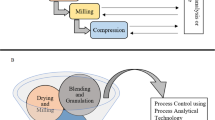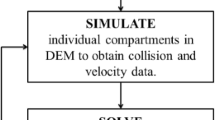Abstract
Using discrete element method (DEM) modeling and near-infrared (NIR) spectroscopy, the feasibility of powder mixing in the initial pre-melting zones of a twin screw extruder using two independent feeders was studied. Previous work in the pharmaceutical and food industry has focused on mixing when materials are melted or on material homogeneity at the extruder’s output. Depending on the formulation, ensuring a fully blended formulation prior to melting may be desired. Experiments were conducted using a Coperion ZSK-18 extruder to evaluate if blend uniformity can be achieved by exploring screw configuration, screw speed, and powder feed rate. As powder exited the extruder and deposited on a conveyor belt, an in-line NIR spectrophotometer measured spectra of material. Chemometric-based models predicted unknown concentrations to evaluate if blend uniformity was achieved. Using the EDEM software, Hertz-Mindlin contact model, and dimensions of the extruder, DEM simulations complemented the experimental work. The DEM computational models provided understanding of mixing patterns inside the extruder at particle scale and helped select the screw configuration before doing experimentation. The simulations showed good axial mixing for all the screw configurations studied, while good cross (radial) mixing was only observed for the screw configuration with 90-degree kneading elements. Therefore, the screw configuration with two 90-degree kneading elements was chosen for the experimental study. The RTD profiles when using a screw configuration with only conveying screw elements are comparable to a plug flow reactor (PFR), while the profiles when using kneading elements are more comparable to an ideal continuous stirred tank reactor (CSTR). For the screw configuration with 90 degrees kneading elements, the mean residence time (MRT) decreases with an increase in the screw speed. Experimental NIR spectra showed that concentrations can be predicted with an error of 2%. It was demonstrated that the twin screw extruder can provide proper dry powder mixing of two powder feed streams based on a unit dose scale, enabling continuous powder mixing prior to the melting zone in the extruder for the formulation studied with a cohesive API. This setup may also work for other types of formulations. These studies can help in developing lean hot melt as well as wet extrusion/granulation processes using twin screw extruders for the continuous manufacturing of oral solid dosage products.








Similar content being viewed by others
References
Harnby N. Chapter 3 - The selection of powder mixers. In: Harnby N, Edwards MF, Nienow AWBT-M in the PI, editors. Oxford: Butterworth-Heinemann; 1992. p. 42–61. Available from: https://www.sciencedirect.com/science/article/pii/B978075063760250024X.
Martin C. Twin screw extruders as continuous mixers for thermal processing: a technical and historical perspective. AAPS PharmSciTech. [Internet]. 2016;17(1):3–19. Available from: http://link.springer.com/10.1208/s12249-016-0485-3.
Crowley MM, Zhang F, Repka MA, Thumma S, Upadhye SB, Battu SK, et al. Pharmaceutical applications of hot-melt extrusion: Part I. Drug Dev Ind Pharm. 2007;33(9):909–26.
PAT — A Framework for Innovative Pharmaceutical Development, Manufacturing, and Quality Assurance | FDA [Internet]. [cited 2021 Feb 13]. Available from: https://www.fda.gov/regulatory-information/search-fda-guidance-documents/pat-framework-innovative-pharmaceutical-development-manufacturing-and-quality-assurance.
Portillo PM, Ierapetritou MG, Muzzio FJ. Characterization of continuous convective powder mixing processes. Powder Technology. 2008;182(3):368–78.
Vanarase AU, Alcalà M, Jerez Rozo JI, Muzzio FJ, Romañach RJ. Real-time monitoring of drug concentration in a continuous powder mixing process using NIR spectroscopy. Chem Eng Sci [Internet]. 2010 [cited 2020 Apr 19];65(21):5728–33. Available from: https://linkinghub.elsevier.com/retrieve/pii/S0009250910000655.
Sen M, Singh R, Vanarase A, John J, Ramachandran R. Multi-dimensional population balance modeling and experimental validation of continuous powder mixing processes. Chem Eng Sci [Internet]. 2012 [cited 2020 Apr 19];80:349–60. Available from: https://linkinghub.elsevier.com/retrieve/pii/S0009250912003739.
Ziegler GR, Aguilar CA. Residence time distribution in a co-rotating, twin-screw continuous mixer by the step change method. J Food Eng. 2003;59(2–3):161–7.
Censi R, Gigliobianco MR, Casadidio C, Di Martino P. Hot melt extrusion: Highlighting physicochemical factors to be investigated while designing and optimizing a hot melt extrusion process. Pharmaceutics. 2018;10(3):89.
Madan S, Madan S. Hot melt extrusion and its pharmaceutical applications. Asian journal of Pharmaceutical Sciences. 2012;7(1).
Dhumal RS, Kelly AL, York P, Coates PD, Paradkar A. Cocrystalization and simultaneous agglomeration using hot melt extrusion. Pharmaceutical Research. 2010;27(12):2725–33.
Patil H, Tiwari RV, Repka MA. Hot-melt extrusion: from theory to application in pharmaceutical formulation. Aaps Pharmscitech. 2016;17(1):20–42.
Lang B, McGinity JW, Williams Iii RO. Hot-melt extrusion–basic principles and pharmaceutical applications. Drug Development and Industrial Pharmacy. 2014;40(9):1133–55.
Meena AK, Desai D, Serajuddin ATM. Development and optimization of a wet granulation process at elevated temperature for a poorly compactible drug using twin screw extruder for continuous manufacturing. J Pharm Sci [Internet]. 2017;106(2):589–600. Available from: https://linkinghub.elsevier.com/retrieve/pii/S0022354916418253.
De Beer T, Burggraeve A, Fonteyne M, Saerens L, Remon JP, Vervaet C. Near infrared and Raman spectroscopy for the in-process monitoring of pharmaceutical production processes. International Journal of Pharmaceutics. 2011;417(1-2):32–47.
Luypaert J, Massart DL, Vander Heyden Y. Near-infrared spectroscopy applications in pharmaceutical analysis. Talanta. 2007;72(3):865–83.
Grassi S, Alamprese C. Advances in NIR spectroscopy applied to process analytical technology in food industries. Current Opinion in Food Science. 2018;22:17–21.
Lee M-J, Seo D-Y, Lee H-E, Wang I-C, Kim W-S, Jeong M-Y, et al. In line NIR quantification of film thickness on pharmaceutical pellets during a fluid bed coating process. International Journal of Pharmaceutics. 2011;403(1-2):66–72.
De Beer TRM, Vercruysse P, Burggraeve A, Quinten T, Ouyang J, Zhang X, et al. In-line and real-time process monitoring of a freeze drying process using Raman and NIR spectroscopy as complementary process analytical technology (PAT) tools. Journal of Pharmaceutical Sciences. 2009;98(9):3430–46.
Florian-Algarin M, Méndez R. Blend uniformity and powder phenomena inside the continuous tumble mixer using DEM simulations. AIChE J [Internet]. 2015;61(3):792–801. Available from: https://aiche.onlinelibrary.wiley.com/doi/abs/10.1002/aic.14694.
Mateo-Ortiz D, Méndez R. Microdynamic analysis of particle flow in a confined space using DEM: The feed frame case. Adv Powder Technol. 2016;27(4):1597–606. https://doi.org/10.1016/j.apt.2016.05.023.
Mateo-Ortiz D, Méndez R. Relationship between residence time distribution and forces applied by paddles on powder attrition during the die filling process. Powder Technol. 2015;278:111–7. https://doi.org/10.1016/j.powtec.2015.03.015.
Mateo-Ortiz D, Muzzio FJ, Méndez R. Particle size segregation promoted by powder flow in confined space: the die filling process case. Powder Technol. 2014;262:215–22.
Behjani MA, Motlagh YG, Bayly AE, Hassanpour A. Assessment of blending performance of pharmaceutical powder mixtures in a continuous mixer using Discrete Element Method (DEM). Powder Technol. 2020;366:73–81. https://doi.org/10.1016/j.powtec.2019.10.102.
Guoming Hu, Jinxin Chen, Bin Jian, Hui Wan, Liping Liu. Modeling and simulation of transportation system of screw conveyors by the Discrete Element Method. In: 2010 International Conference on Mechanic Automation and Control Engineering [Internet]. IEEE; 2010. p. 927–30. Available from: http://ieeexplore.ieee.org/document/5536244/.
Wu H, Khan MA. Quality-by-design (QbD): an integrated approach for evaluation of powder blending process kinetics and determination of powder blending end-point. J Pharm Sci [Internet]. 2009;98(8):2784–98. Available from: https://linkinghub.elsevier.com/retrieve/pii/S0022354916330416.
Scheibelhofer O, Balak N, Wahl PR, Koller DM, Glasser BJ, Khinast JG. Monitoring blending of pharmaceutical powders with multipoint NIR spectroscopy. AAPS PharmSciTech. 2013;14(1):234–44.
Sierra-Vega NO, Román-Ospino A, Scicolone J, Muzzio FJ, Romañach RJ, Méndez R. Assessment of blend uniformity in a continuous tablet manufacturing process. Int J Pharm [Internet]. 2019;560:322–33. Available from: https://linkinghub.elsevier.com/retrieve/pii/S0378517319301152.
Ortega-Zúñiga C, la Rosa CP, De R-O, Serrano-Vargas A, Romañach RJ, Méndez R. Development of near infrared spectroscopic calibration models for in-line determination of low drug concentration, bulk density, and relative specific void volume within a feed frame. J Pharm Biomed Anal. 2019;5(164):211–22.
Mateo-Ortiz D, Colon Y, Romañach RJ, Méndez R. Analysis of powder phenomena inside a Fette 3090 feed frame using in-line NIR spectroscopy. J Pharm Biomed Anal. 2014;100:40–9.
The United States pharmacopeia and National formulary (USP 35-NF 30). Rockville (MD): United States Pharmacopeial Convention. Powder Flow. 2012;801–4.
Colón YM, Florian MA, Acevedo D, Méndez R, Romañach RJ. Near infrared method development for a continuous manufacturing blending process. J Pharm Innov [Internet]. 2014;9(4):291–301. Available from: http://link.springer.com/10.1007/s12247-014-9194-1.
Puaux J, Bozga G, Ainser A. Residence time distribution in a corotating twin-screw extruder. Chem Eng Sci [Internet]. 2000;55(9):1641–51. Available from: https://linkinghub.elsevier.com/retrieve/pii/S0009250999004303.
Grima AP, Wypych PW. On improving the calibration and validation of computer simulations for bulk materials handling systems. Aust Bulk Handl Rev. 2009;14(5):84–91.
Grima A, Wypych P. Discrete element simulation of a conveyor impact-plate transfer: calibration, validation and scale-up. Australian Bulk Handling Review. 2010;3:64–72.
Zhou YC, Wright BD, Yang RY, Xu BH, Yu AB. Rolling friction in the dynamic simulation of sandpile formation. Phys A Stat Mech its Appl. 1999;269(2):536–53.
Boac JM, Casada ME, Maghirang RG, Harner JP III. Material and interaction properties of selected grains and oilseeds for modeling discrete particles. Trans ASABE [Internet]. 2010;53(4):1201–16. Available from: http://elibrary.asabe.org/abstract.asp??JID=3&AID=32577&CID=t2010&v=53&i=4&T=1.
Zhou YC, Xu BH, Yu AB, Zulli P. An experimental and numerical study of the angle of repose of coarse spheres. Powder Technol [Internet]. 2002;125(1):45–54. Available from: https://linkinghub.elsevier.com/retrieve/pii/S0032591001005204.
Andrew PG, Peter WW. Discrete element simulations of granular pile formation: method for calibrating discrete element models. Eng Comput. 2011;28(3):314–39. https://doi.org/10.1108/02644401111118169.
Khanal M, Elmouttie M, Adhikary D. Effects of particle shapes to achieve angle of repose and force displacement behaviour on granular assembly. Adv Powder Technol. 2017;28(8):1972–6.
Nakashima H, Shioji Y, Kobayashi T, Aoki S, Shimizu H, Miyasaka J, et al. Determining the angle of repose of sand under low-gravity conditions using discrete element method. J Terramech. 2011;48(1):17–26.
Qi L, Chen Y, Sadek M. Simulations of soil flow properties using the discrete element method (DEM). Comput Electron Agric. 2019;1(157):254–60.
Beakawi Al-Hashemi HM, Baghabra Al-Amoudi OS. A review on the angle of repose of granular materials. Vol. 330, Powder Technology. Elsevier B.V.; 2018. p. 397–417.
Hlosta J, Jezerská L, Rozbroj J, Žurovec D, Nečas J, Zegzulka J. DEM investigation of the influence of particulate properties and operating conditions on the mixing process in rotary drums: Part 2-process validation and experimental study. Processes. 2020;8(2):1–26.
Author information
Authors and Affiliations
Corresponding author
Ethics declarations
Conflict of interest
Daniel Mateo-Ortiz, Dana Alhasson, Gregory D. Doddridge, and Michael C. Dennis are employees of AbbVie and may own AbbVie stock. Shashank Venkat Muddu is a prior employee of AbbVie and is now a student at Rutgers University. Vladimir Villanueva-Lopez is also a prior employee of AbbVie and is now a student at University of Puerto Rico Mayaguez Campus. Shashank Venkat Muddu and Vladimir Villanueva-Lopez have no conflicts of interest to report. AbbVie sponsored and funded the study; contributed to the design; participated in the collection, analysis, and interpretation of data, and in writing, reviewing, and approval of the final publication.
Additional information
Guest Editors: Alexander Russell and Maxx Capece
Publisher's Note
Springer Nature remains neutral with regard to jurisdictional claims in published maps and institutional affiliations.
Supplementary Information
Below is the link to the electronic supplementary material.
Supplementary file1 (WMV 4786 KB)
Supplementary file2 (WMV 4239 KB)
Rights and permissions
About this article
Cite this article
Mateo-Ortiz, D., Villanueva-Lopez, V., Muddu, S.V. et al. Dry Powder Mixing Is Feasible in Continuous Twin Screw Extruder: Towards Lean Extrusion Process for Oral Solid Dosage Manufacturing. AAPS PharmSciTech 22, 249 (2021). https://doi.org/10.1208/s12249-021-02148-x
Received:
Accepted:
Published:
DOI: https://doi.org/10.1208/s12249-021-02148-x




